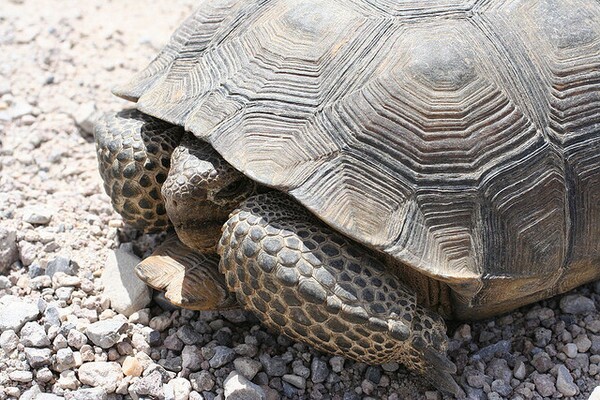Solar Power Project on Indian Reservation Not Immune From Tortoise Trouble

It's a compelling, heroic narrative: a Native tribe fights to close a coal plant that's poisoned its people, and builds a solar power plant next door as an alternative source of power. A city far away that's been buying coal-fired power decides to go coal-free, and agrees to buy all the power from the tribe's solar plant. The credits roll and everyone feels good.
Everyone, that is, except a threatened desert reptile that's had to move out of the way.
In spring 2013, wildlife biologists moved 157 desert tortoises, a federally listed threatened species, from the 2,000-acre footprint of the Moapa Solar power plant, being built by First Solar on the Moapa Paiute reservation in the shadow of the doomed Reid-Gardner Generating Station. Since those translocations, according to the U.S. Fish and Wildlife Service, at least ten tortoises have died from predation and from heat exhaustion.
The Moapa project has been heralded, including by ReWire, as a healthier alternative to the coal-fired Reid-Gardner plant, which is now scheduled to be shut down by 2017.
The Los Angeles Department of Water and Power will be buying all the power the 250-megawatt Moapa plant produces.
The estimates of tortoise mortality at Moapa were included in USFWS's Biological Opinion (BiOp) on desert tortoises for the Silver State South and Stateline solar projects in the Ivanpah Valley. The language in the BiOp is stark, offering Moapa's experience as a cautionary tale for what can be expected for the two Ivanpah Valley projects:
[W]e expect that translocated animals would spend more time moving, at least during the first year, which means they would be more vulnerable to predators, adverse interactions with other desert tortoises, and weather conditions than resident or control animals. For example, in spring 2013, biologists translocated 108 large and 49 small desert tortoises from approximately 2,000 acres of the KRoad Moapa Solar Project on the Moapa River Indian Reservation northeast of Las Vegas... Extremely high temperatures during the summer may have killed two or more large translocated desert tortoises. Predators likely killed eight small translocated desert tortoises.... During this first year of increased movement, desert tortoises would also be more likely to engage in fence pacing behavior, which can lead to hyperthermia and death.
K-Road sold the Moapa project to First Solar in September.
Compared to the numbers of tortoises affected by projects in the Ivanpah Valley, which run into the thousands per project, 157 relocated tortoises rom 2,000 acres of land may not seem like a lot.
But those 157 tortoises evicted from the Moapa project footprint this spring are more than USFWS expected to find at the Genesis, Blythe, Palen, Desert Sunlight, McCoy, Desert Harvest, and Rice solar projects in California combined, according to the Silver State South BiOp. Those projects, in progress or planned, cover 21,635 acres of tortoise habitat compared to Moapa's 2,152 acres.
In other words, while Ivanpah Valley seems to be tortoise habitat in a league of its own -- or at least it was -- the Moapa site was apparently top-notch tortoise habitat compared to places other than Ivanpah, and siting a solar plant there might not have been the best choice from an endangered species conservation standpoint.
Another solar energy project, the 850-acre Moapa Solar Energy Center, is being proposed for other reservation lands. That project is currently going through environmental review. It would destroy about 950 acres of tortoise habitat, and the project's biologists estimate the project and an associated pipeline could displace or kill as many as 331 adult tortoises, juveniles and eggs.
Whether those tortoises will earn a mention in the new project's heroic narrative remains to be seen.


